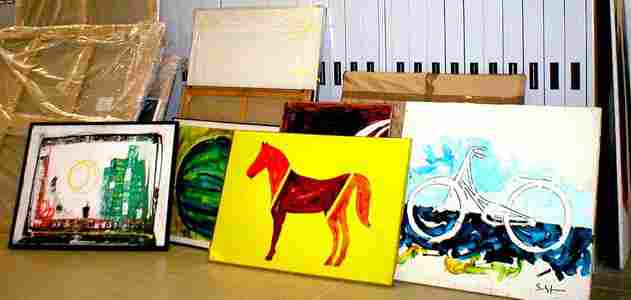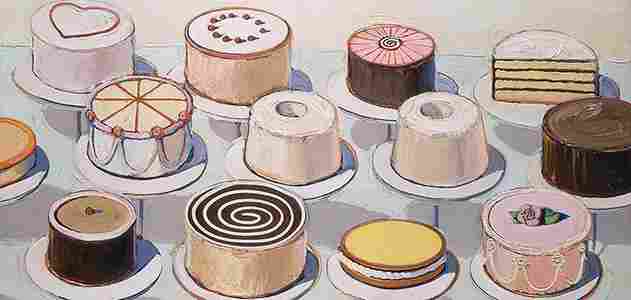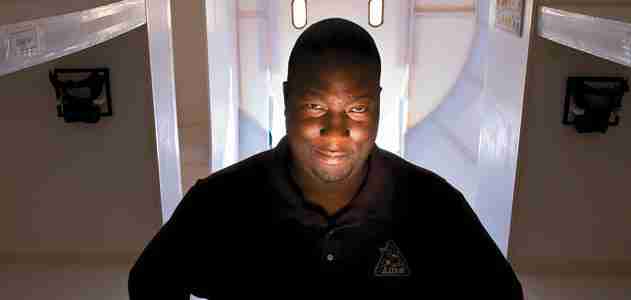Showcasing Shams

Salvatore Casillo should be a happy man. The museum he runs in southern Italy—Museo del Falso—recently acquired a large collection of works attributed to contemporary Italian pop artist Mario Schifano, whose paintings have fetched up to $500,000 at auction. Any day now, the museum will take possession of thousands of oil paintings, drawings, lithographs and prints ascribed to other famous artists, including Andy Warhol. The best part? The museum pays nothing—not a cent, not a euro—for this art trove.
Here's the catch: the works are fakes. They come courtesy of the Carabinieri, Italy's military police, and its Department for the Protection of Cultural Heritage—the biggest anti-art fraud task force in the world, with 280 agents operating in 11 Italian cities. Instead of being destroyed, as they were in the past, the fraudulent pieces will live to see another day in the Museum of Fakes, established in 1991 as part of the University of Salerno's Center for the Study of Forgery. A 2003 agreement between the university and the Carabinieri, the first of its kind, makes the museum the repository for all bogus artworks confiscated in Italy—a country so rich in art treasures that it has traditionally been a kind of candy store for forgers.
The works Casillo will receive represent a fraction of the 60,000 fakes sequestered by the Carabinieri in the past seven years and were seized primarily in southern Italy. The 'Schifano' pieces were taken from a show in 2005 at the prestigious former royal palace in Caserta. The 4,000 or so others, including the 'Warhols,' were seized from raids on print shops, galleries and warehouses across Italy and especially around the town of Cosenza.
Casillo, the museum’s director, is an author and sociologist who has spent 20 years studying counterfeits of all kinds. The museum’s mission is "to analyze the evolution of forgery, from technique to organization," he says, "and to give visitors the opportunity to see firsthand how the counterfeiters carry out their deception."
Unlike the works that hang on its walls, the Museum of Fakes resembles no other. Located in the basement of a university building, it is both storeroom and gallery. Phony Grecian urns line shelves while some paintings are still packed in brown paper (they can't be displayed until courts have dealt with the cases, which can take years). Other objects are filed in metal cabinets or displayed on the walls. Scattered around the place are bundles containing trickster tools of trade: paints, canvases, chemicals, anything used to make the piece look authentic.
Art forgery, explains Casillo, has been around since antiquity. By the end of the Middle Ages, so many fragments of the "true cross" existed that it was said 300 people would not have been able to carry it if all had been authentic. In 1528, when the German master Albrecht Dürer died, there were more fake Dürers on the market than real ones. Casillo says that in 1961 in the United States alone, 100,000 paintings were attributed to Jean-Baptiste-Camille Corot (1796 – 1875), the most copied artist in the world, even though he produced only about 3,000 paintings in his lifetime.
Casillo says that counterfeiting is a group effort involving a chain of corruption that ends at the unscrupulous seller's door. He tells of an instance when the Carabinieri went to the home of a collector to recover a fake Schifano. The owner insisted his was the real thing because the artist had been present at the purchase. As proof he showed the police a picture of himself with the painting, shaking hands with the man he identified as Schifano, who turned out to be an impersonator hired by the corrupt art gallery owner.


If forgery is a team effort, there is no question who the rainmakers are: artists sometimes so talented, says Casillo, that the best ones would never have been discovered had they not revealed themselves.
In an ironic twist of fate, some master forgers are now getting respect from the art establishment they challenged and, in some cases, convulsed. London's Victoria and Albert Museum has a separate gallery devoted to first-class fakes and forgeries. Other respected museums around the world are giving the counterfeiters—long the object of public fascination—shows of their own.
In a recent exhibit of 60 imposters, the Bruce Museum in Greenwich, Connecticut, included a milestone fake— Christ and His Disciples at Emmaus —sold as a genuine Johannes Vermeer (1632 – 1675) for the equivalent of $4.7 million in 1937, but later determined to be the work of Dutch forger Han van Meegeren (1889 – 1947). Doubt about its authenticity came in 1945 when van Meegeren, having been accused by the Dutch police of selling a national treasure (another Vermeer) to the Nazis, declared that the "Vermeers" were his own work. To prove this, he then painted one in front of witnesses.
A show in 2004 at Siena's Santa Maria della Scala in Italy honored gifted counterfeiters of the 19th and 20th centuries, regarded as the golden age of forgery. Those featured included Icilio Federico Joni (1866 – 1946), known as the prince of Sienese fakers. After turning out exquisite but phony Renaissance religious paintings, Joni outed himself in a 1932 autobiography, gleefully describing how he managed to fool the experts.
"The forger is generally a talented person who has not made it in his own right and avenges himself by hiding behind works of successful artists," says art historian Gianni Mazzoni of the University of Siena and the exhibit's curator. "He takes particular pleasure when art critics and experts are taken in."
The forger who most impressed Casillo was Alceo Dossena (1873 – 1937), whose works were also featured in Siena. The Italian sculptor is often described as the greatest counterfeiter of them all. Dossena rocked the art world in 1928 by revealing that he was behind some of the most prized works in prestigious collections and museums, including the Metropolitan and the Boston Museum of Fine Arts. He blew the whistle on the corrupt dealers who had been selling his sculptures as the work of Donatello and other revered Renaissance artists after the merchants refused him money to bury his wife.
So, are fakes real art? Mazzoni says that for master counterfeiters like Dossena and Eric Hebborn (1934 – 1996), whose book, The Art Forger's Handbook, gives detailed instructions on creating "old masters," talent trumps forgery, making their pieces true "works of art."
Which brings us back to the Museum of Fakes. "Through the most beautiful fakes," Casillo says "we want to keep alive the memory of a history of art, which, although perverse, is often fascinating."
Dina Modianot-Fox , a regular Smithsonianom contributor, reported this story from Salerno, Italy.
Rogues Gallery

Every day a work of art is stolen somewhere in the world. Thieves rip paintings from walls, sever canvases from their frames with razors or even screwdrivers, raid warehouses with assault rifles, saw sculptures from their bases with chainsaws and haul them away in trucks. In February, three masked men raided the E.G. Burhle Collection, a small museum in Zurich, Switzerland. At gunpoint, they forced patrons and museum staffers to the floor and made off with four 19th-century paintings worth about $165 million. Two of the paintings were later found in an unlocked car parked at a psychiatric facility, less than a mile from the museum. The thieves and the other two paintings remain missing. According to the Art Loss Register, a private company that tracks and recovers purloined art, at least 10,500 works of art and antiquities were stolen last year.
Art crime's history is long and bloody, dominated by the plundering of invading armies. Think of the eight Egyptian obelisks that still anchor the piazzas of Rome, spoils of the ancient Roman Empire's conquest of the Nile kingdom. Napoleon famously looted thousands of pieces from Italy. And innumerable works were stolen by the Nazis, forcibly sold, or otherwise lost, during World War II.
More recently, museums and ancient sites in Afghanistan and Iraq have suffered massive losses amid armed conflict while countries such as Cambodia, with rich artistic histories but meager resources to protect them, see their treasures smuggled out of the country and lost to history.
Most art crime, however, occurs on a much smaller scale, with about 40 percent of thefts reported to the Art Loss Register coming from private homes or collections and about 15 percent from museums and galleries. Whether it's a dramatic museum heist or opportunistic house-burglary, all of them fuel a lucrative black market. Because most thefts go unreported, the illegal trade in art and antiquities amounts to roughly a $6-billion a year industry. What's stolen changes with the fashion of the times, but unlike the stock market, the market for stolen art and antiquities has never and likely never will collapse.
Click here to view a slideshow of the past 100 years' ten most incredible art heists.


What’s Up

Drone Home The U.S. military began building unmanned aircraft for combat and surveillance in 1918. Now, six drones are on permanent display at the Air and Space Museum, including the Boeing X-45A.
Postmodern Posters Advertisements can become art, as shown by a whimsical 1918 poster of actor Charlie Chaplin. Learn more at "Ballyhoo! Posters as Portraiture" at the National Portrait Gallery through February 8.
Art with a Feeling Charles Lang Freer, a Detroit industrialist and museum founder, loved the rich texture of paintings like the 1891 Piano by Thomas Dewing. "Surface Beauty," now on long-term view at the Freer Gallery, showcases works from his collection.
Old Ballgame "Separate and Unequaled" follows black baseball in the nation's capital, from the sandlot to the ballpark. The Anacostia Museum's show is at the Historical Society of Washington D.C. until October 5.
The Muppets take D.C. Jim Henson's puppets, from odd-couple roommates Bert and Ernie to Kermit the Frog, populate a "Fantastic World," on display at the International Gallery from July 12 until October 5.




Post a Comment